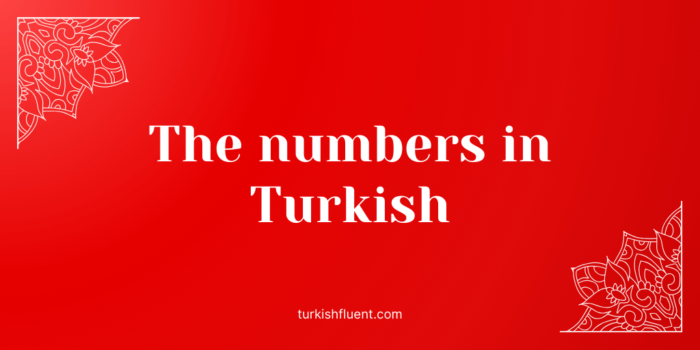When learning a language, you need to learn how to properly say the numbers. This article will teach you everything you need to know about Turkish numbers. We will teach you cardinal numbers first and the the ordinal numbers. Hadi başlayalım!
Table of Contents
Cardinal Numbers in Turkish (from 0 to 1 million)
Cardinal numbers are the basic numbers used for counting (one, two, three, etc.). Here is a list of cardinal numbers in Turkish from 0 to 20 and by tens up to 100.
Numbers from 0 to 20:
| Number | Turkish | English Translation |
|---|---|---|
| 0 | sıfır | zero |
| 1 | bir | one |
| 2 | iki | two |
| 3 | üç | three |
| 4 | dört | four |
| 5 | beş | five |
| 6 | altı | six |
| 7 | yedi | seven |
| 8 | sekiz | eight |
| 9 | dokuz | nine |
| 10 | on | ten |
| 11 | on bir | eleven |
| 12 | on iki | twelve |
| 13 | on üç | thirteen |
| 14 | on dört | fourteen |
| 15 | on beş | fifteen |
| 16 | on altı | sixteen |
| 17 | on yedi | seventeen |
| 18 | on sekiz | eighteen |
| 19 | on dokuz | nineteen |
| 20 | yirmi | twenty |
Counting by Tens up to 100:
| Number | Turkish | English Translation |
|---|---|---|
| 30 | otuz | thirty |
| 40 | kırk | forty |
| 50 | elli | fifty |
| 60 | altmış | sixty |
| 70 | yetmiş | seventy |
| 80 | seksen | eighty |
| 90 | doksan | ninety |
| 100 | yüz | one hundred |
Forming Numbers Beyond 100
After 100, the pattern is straightforward:
- 101 is “yüz bir,” 110 is “yüz on,” 120 is “yüz yirmi,” and so on.
- 200 is “iki yüz,” 300 is “üç yüz,” and so on.
- 1,000 is “bin,” 2,000 is “iki bin,” etc.
The pattern continues for larger numbers such as “on bin” (10,000), “yüz bin” (100,000), and “milyon” (1,000,000). Infinity is named
Ordinal Numbers in Turkish
Ordinal numbers in Turkish indicate a position or order, such as “first,” “second,” “third,” etc. They are formed by adding the suffix “-inci” to the cardinal numbers.
Note that the suffix “-inci” changes to “-ıncı,” “-inci,” “-üncü,” or “-uncu” depending on vowel harmony rules.
Ordinal Numbers from first to tenth:
| Number | Turkish | English Translation |
|---|---|---|
| 1st | birinci | first |
| 2nd | ikinci | second |
| 3rd | üçüncü | third |
| 4th | dördüncü | fourth |
| 5th | beşinci | fifth |
| 6th | altıncı | sixth |
| 7th | yedinci | seventh |
| 8th | sekizinci | eighth |
| 9th | dokuzuncu | ninth |
| 10th | onuncu | tenth |
The ordinal numbers beyond “10th” follow the same logic:
- 11th => on birinci
- 22nd => yirmi ikinci
- 110 => yüz onuncu
- etc.
Mathematical operators in Turkish
To finish this article, here is a list of a few mathematical operators you can learn along with the numbers in Turkish:
| Operator Symbol | Turkish Word | English Translation |
|---|---|---|
| + | artı | plus |
| – | eksi | minus |
| × or * | çarpı | multiplied by |
| ÷ or / | bölü | divided by |
| = | eşittir | equals |
| % | yüzde | percent |
| ^ | üstü | raised to the power |
| √ | karekök | square root |
| > | büyüktür | greater than |
| < | küçüktür | less than |
| ≥ | büyüktür veya eşittir | greater than or equal to |
| ≤ | küçüktür veya eşittir | less than or equal to |
| ≠ | eşit değildir | not equal to |
Examples:
- Bir artı bir eşittir iki. (One plus one is equal to two)
- On bölü iki, beşe eşittir. (Ten divided by two is equal to five.)
- İki ile yüzün çarpımı iki yüze eşittir. (The multiplication of two and one hundred is equal to two hundred.)
